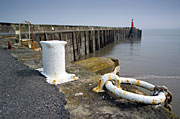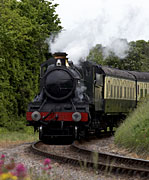It is believed that Watchet began with the arrival of St Decuman from what is now South Wales. Legend says that he arrived on a raft with only a cow as companion. A pebble stone mosaic next to the library on the Esplanade depicts this journey. The local church is still dedicated to the saint and there is a Holy Well, where some of his healing is said to have taken place, just below the church.
Remains of an Iron Age fort at Daw’s Castle, west of the town, indicate the early importance of Watchet as a strategic site. At Doniford, to the east of the town, some traces of Roman settlement have been found.
 The settlement was called “Wecedport” by the Saxons and the natural harbour made it an obvious trading centre, situated in a creek on the coast of the Bristol Channel. On several occasions during the 9th and 10th centuries, it was invaded and burnt by the Vikings. Some of the booty from these raids may be seen today in the museum in Stockholm, including 10th century coins, minted for several Saxon kings.
The settlement was called “Wecedport” by the Saxons and the natural harbour made it an obvious trading centre, situated in a creek on the coast of the Bristol Channel. On several occasions during the 9th and 10th centuries, it was invaded and burnt by the Vikings. Some of the booty from these raids may be seen today in the museum in Stockholm, including 10th century coins, minted for several Saxon kings.
Following the death of King Harold at the Battle of Hastings, his mother fled to Watchet, from where she sailed to Flatholm Island. The town was subsequently given by King William to William de Mohun and is mentioned in the Domesday Book. The manor of Dunster was created and a castle was built. Watchet celebrates its links to the past by symbolically maintaining the mediaeval Court Leet system of local administration; individuals are still appointed to posts such as Ale Taster and Portreeve.
During the 19th century, a considerable trade was carried on in grain, flour, malt, coal, and timber. In addition, iron ore was exported from the mines in the Brendon Hills to South Wales. There was an iron foundry, many paper mills, a lime works, and a cloth factory. Records show that the population of the town in 1861 was about 1,000. It was a coastguard station, and manorial courts were held each year. Vessels traded along the coast and cargo manifests can still be seen in the Market House Museum. Wood pulp for the paper mills was imported from Scandinavia and Portugal.
 In 1862 a broad gauge railway was built, eventually stretching as far as Minehead. This was closed in 1970, but reopened a few years later as the West Somerset Railway, run by steam enthusiasts. At one time Watchet also had another railway, The Mineral Line, which ran between the town and Washford, then into the Brendon Hills. It was used for bringing iron ore from the hills into Watchet, for shipping to Wales. The track has long gone but the route can be followed on foot. From the Esplanade, the Old Mineral Line Trail passes the Paper Mill and through countryside as far as Washford Station which is now the Somerset and Dorset Railway Museum.
In 1862 a broad gauge railway was built, eventually stretching as far as Minehead. This was closed in 1970, but reopened a few years later as the West Somerset Railway, run by steam enthusiasts. At one time Watchet also had another railway, The Mineral Line, which ran between the town and Washford, then into the Brendon Hills. It was used for bringing iron ore from the hills into Watchet, for shipping to Wales. The track has long gone but the route can be followed on foot. From the Esplanade, the Old Mineral Line Trail passes the Paper Mill and through countryside as far as Washford Station which is now the Somerset and Dorset Railway Museum.
The poet, Samuel Taylor Coleridge is recorded as having stayed at the Bell Inn in Market Street. It is believed that Coleridge wrote “The Rime of the Ancient Mariner”, probably his most famous poem, whilst staying in Watchet. The mariner is said to have set sail from Watchet and a statue depicting him overlooks the harbour.
Today Watchet is a bustling town with a great deal to recommend it. The narrow streets of oldest part of the town lie around the harbour, now a new marina since the decline in coastal trade. The original market place was situated behind the Esplanade close to the junction with Swain Street, the town’s main commercial artery. There is a wide variety of shops, including some small individual places in addition to the high street chain stores. These include antique and curio shops and galleries.
Watchet Market House Museum has many interesting displays about the history of the town, particularly about the Old Mineral Line of the local railway and papermaking, which was one of the major industries of the past. Watchet Boat Museum is dedicated to the various fishing, barge and river boats
Holy Cross Chapel originally dates back to the 12th century. The family of Reginald Fitz Urse, one of the knights who murdered Thomas a Becket, built a chapel by the harbour. They paid a chaplain to pray here, presumably asking for forgiveness for the dirty deed! The chapel was rebuilt in 1833 and is open to the public. The church of St Decuman also has a similar connection. It was built by two of the Knights who murdered Thomas a Becket. Much of it dates from the 15th century, when it was expanded by the Wyndham family. The rood screen and the wagon roof are worthy of note.
The cliffs in the vicinity are embedded with fossil fish, ichthyosauri, ammonites and other relics. There are even the remains of a woolly mammoth! Some spectacular faults can be seen and there are fossil casts of giant ammonites on the foreshore. Apparently, Daniel Defoe, author of “Robinson Crusoe”, was amazed by the fossils he discovered here at Watchet. The shingle beach may be disappointing to some, but there are plenty of rock pools in which children are fascinated. Sandy beaches are further down the coast at Blue Anchor and Minehead.
Fishing trips and boat trips are available from the harbour and there are many superb walks along the coast from Watchet. There are also plenty of hill walks; the Quantocks, the Brendon Hills and Exmoor are all fairly close at hand. There is plenty for the tourist to see and do in Watchet itself, including an interesting wildlife park with lots of activities for children.
Watchet is a nice little town, with plenty of tourist accommodation. There are some nice cafés and plenty of restaurants and pubs. It is a convenient place from which to explore the Somerset coast, and is within easy reach of larger places such as Bath and Bristol.



